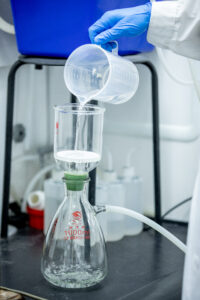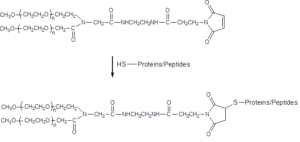 JenKem Technology provides high quality activated polyethylene glycol derivatives (PEGs) with high purity and low polydispersity for Thiol PEGylation or Sulfhydyl PEGylation.
JenKem Technology provides high quality activated polyethylene glycol derivatives (PEGs) with high purity and low polydispersity for Thiol PEGylation or Sulfhydyl PEGylation.
Methoxy PEG Maleimide is selective for thiol groups on cystein side chains. Y-shape PEG Maleimide is more selective, due to its sterically bulky structure. The bulky structure of JenKem Technology’s proprietary Y-shape branched PEG derivatives, consisting of two linear methoxy PEG chains attached to a central core with an active maleimide group, may help to reduce the number of attachment sites to a protein molecule.
Methoxy PEG Vinylsulfone is a sulfhydryl reactive PEG that reacts at high pH. Methoxy PEG Thiol polydisperse or monodisperse PEGs are thiol reactive towards the SH groups on cysteine side chains under mild reaction conditions. PolyLactide PEG Maleimide (PLA PEG Maleimide) is a biodegradable thiol reactive PEG co-polymer usually employed for controlled drug release.
Activated PEG products for thiol PEGylation with molecular weights, branching, and functional groups not listed in our online catalog may be available by custom synthesis. Please inquire at tech@jenkemusa.com about pricing and availability of custom PEGs for thiol PEGylation, and PEGylation services.
JenKem Technology provides GMP grade PEG derivatives and bulk orders via

Scheme of Thiol PEGylation with JenKem® Y-PEG-MAL
custom synthesis, offering the opportunity to match customers’ special quality requirements. JenKem Technology is capable of development and synthesis of a wide range of GMP PEG derivatives in 200g to 40 kg or greater batches, under ISO 9001 and ISO 13485 certified quality management system, following ICH Q7A guidelines. In 2020 JenKem Technology will start to use High Purity (> 99%) mPEG Raw Materials to manufacture GMP grade Methoxy PEG Derivatives. For inquiries on cGMP production of PEG derivatives please contact us at tech@jenkemusa.com.
For global distribution, please visit link. Click the buttons below to order directly from JenKem Technology:
Y-shaped PEG Maleimide
| PEG PRODUCT | SUBSTITUTION | REACTIVITY DETAILS |
|---|---|---|
| ≥ 95% | Y-shape PEG Maleimide reacts with thiol groups at pH 5.0-6.5. JenKem proprietary Y-shape PEGs are more selective, due to their sterically bulky structure.[1] |
U-shaped Branched PEG Maleimide
| PEG PRODUCT | SUBSTITUTION | REACTIVITY DETAILS |
|---|---|---|
| ≥ 95% | MPEG2 Maleimide with superior quality; reacts with thiol groups on cystein side chains, such as thiols on certolizumab [28] |
Linear Methoxy PEG Maleimide
| PEG PRODUCT | SUBSTITUTION | REACTIVITY DETAILS |
|---|---|---|
| ≥ 95% | Methoxy PEG Maleimide from JenKem Technology is a thiol reactive PEG derivative selective for thiol groups on cysteine side chains. Methoxy PEG Maleimide undergoes thiol PEGylation reactions with thiol-containing molecules at pH 5.0-6.5. [2-4], [15-20]. |
Linear Methoxy PEG Iodoacetamide
| PEG PRODUCT | SUBSTITUTION | REACTIVITY DETAILS |
|---|---|---|
| ≥ 90% | Methoxy PEG Iodoacetamide from JenKem Technology is a PEG derivative reacting with thiol groups on cysteine side chains. |
Linear Methoxy PEG Vinylsulfone
| PEG PRODUCT | SUBSTITUTION | REACTIVITY DETAILS |
|---|---|---|
| ≥ 90% | Methoxy PEG Vinylsulfone are high quality products for sulfhydryl PEGylation. Methoxy Vinylsulfone PEG products are special thiol PEGylation PEGs that react at high pH. [5] |
Linear Methoxy PEG Thiol
| PEG PRODUCT | SUBSTITUTION | REACTIVITY DETAILS |
|---|---|---|
| ≥ 95% | Methoxy PEG Thiol is a high quality activated PEG product for thiol pegylation. Methoxy PEG Thiol PEGylates the thiol groups on cysteine side chains under mild reaction conditions.[6-9], [21-25]. | |
| ≥ 90% | Methoxy PEG5 Thiol and Methoxy PEG6 Thiol monodisperse Methoxy PEG Thiol products for thiol PEGylation in mild conditions. [10] |
Linear Methoxy PEG Acrylate
| PEG PRODUCT | QUALITY | REACTIVITY DETAILS |
|---|---|---|
| ≥ 90% Substitution | Methoxy PEG Acrylate a thiol-reactive PEG, reacting with sulfhydryl groups via Michael addition reactions. Acrylate groups are typically involved in vinyl photopolymerization or co-polymerization. [33] | |
| ≥ 90% Purity | Methoxy PEG5 Acrylate and Methoxy PEG6 Acrylate monodisperse Methoxy PEG Acrylate products for thiol PEGylation. [34] |
Biodegradable PolyLactide PEG Maleimide Co-Polymers (PLA PEG Maleimide)
| PEG PRODUCT | PURITY | ITEM DESCRIPTION |
|---|---|---|
| ≥90% | MAL-PEG5000-b-PLA20K, Maleimide Polyethylene Glycol Polylactide block copolymer, PEG MW 5000, PLA MW 20000, Substitution (Maleimide) ≥ 70%. Biodegradable PEG for controlled release applications. | |
| ≥90% | MAL-PEG2000-b-PLA2000, Maleimide Polyethylene Glycol Polylactide block copolymer, PEG MW 2000, PLA MW 2000, Substitution (Maleimide) ≥ 70%. Biodegradable PEG for controlled release applications. |
Homobifunctional Activated PEG for Thiol PEGylation
| PEG PRODUCT | SUBSTITUTION | REACTIVITY DETAILS |
|---|---|---|
| > 90% | Maleimide PEG Maleimide. Selective crosslinker for thiol groups on cystein side chains. [11] | |
| ≥ 95% | Thiol PEG Thiol. Thiol reactive PEG crosslinker, reacts with HS groups on cysteine side chains under mild reaction conditions. [12], [26]. | |
| > 90% | Vinylsulfone PEG Vinylsulfone. Sulfhydryl reactive homobifunctional PEG crosslinker [13, 14, 27]. | |
| > 90% | Tosylate PEG Tosylate. Tosylate PEG Tosylate (diTosylate PEG, diToluenesulfonyl PEG, or PEG (Tosylate)2) is employed for amine and thiol pegylation. | |
| ≥ 95% | PEG diAcrylate. Thiol reactive PEG crosslinker. [29-32] |
Monodisperse Heterobifunctional PEGs Functionalized with Thiol
Heterobifunctional PEGs Functionalized with Thiol Reactive Groups
Multiarm Homofunctional PEGs Functionalized with Thiol Reactive Groups
Multiarm Heterobifunctional PEGs Functionalized with Thiol Reactive Groups
References:
- Li, H., et al., Dual MMP7-Proximity-Activated and Folate Receptor-Targeted Nanoparticles for siRNA Delivery, Biomacromolecules, 2015, 16 (1), p: 192–201.
- Umeshappa, C. S., et al., Liver-specific T regulatory type-1 cells program local neutrophils to suppress hepatic autoimmunity via CRAMP, Cell Reports, 2021, V. 34(13).
- Shen, L., et al., Facile synthesis of organosilica-capped mesoporous silica nanocarriers with selective redox-triggered drug release properties for safe tumor chemotherapy, Biomaterials science, 2019.
- Kaminskas, L.M., et al., A 30 kDa polyethylene glycol-enfuvirtide complex enhances the exposure of enfuvirtide in lymphatic viral reservoirs in rats, European Journal of Pharmaceutics and Biopharmaceutics, 2019.
- Mahou, R., et al., Injectable and inherently vascularizing semi-interpenetrating polymer network for delivering cells to the subcutaneous space, Biomaterials, 2017.
- Wang, X.-M., et al., Exposure-time-dependent subcellular staging of gold nanoparticles deposition and vesicle destruction in mice livers, Nanomedicine: Nanotechnology, Biology and Medicine, 2021, V. 34.
- Han, L., et al., Surface-enhanced resonance Raman scattering guided brain tumor surgery showing prognostic benefit in rat models, ACS applied materials & interfaces, 2019.
- Liu, Y., et al., Cathodic protected Mn2+ by NaxWO3 nanorods for stable magnetic resonance imaging-guided tumor photothermal therapy, Biomaterials, 2020, V. 234.
- Guo, T., et al., Highly-selective detection of EGFR mutation gene in lung cancer based on surface enhanced Raman spectroscopy and asymmetric PCR, Journal of Pharmaceutical and Biomedical Analysis, 2020, 190,113522.
- Mei, L., et al., Increased tumor targeted delivery using a multistage liposome system functionalized with RGD, TAT and cleavable PEG. International Journal of Pharmaceutics, 2014, 468(1–2): p. 26-38.
- Day, J.R., et al., The impact of functional groups of poly(ethylene glycol) macromers on the physical properties of photo-polymerized hydrogels and the local inflammatory response in the host, Acta Biomaterialia, 2018, V. 67, P. 42-52.
- Bae, S.W., et al., Dynamic, Bioresponsive Hydrogels via Changes in DNA Aptamer Conformation, Macromolecular bioscience, 2019, 19(2):1800353.
- Li, H., et al., Bioengineered three-dimensional scaffolds to elucidate the effects of material biodegradability on cell behavior using POSS-PEG hybrid hydrogels, Polymer Degradation and Stability, 2019, 164:118-26.
- Day, J.R., et al., The impact of functional groups of poly(ethylene glycol) macromers on the physical properties of photo-polymerized hydrogels and the local inflammatory response in the host, Acta Biomaterialia, 2018, 67, P. 42-52.
- DeGroot, A.C., et al., Entropic control of receptor recycling using engineered ligands, Biophysical journal, 2018, 114(6), p.1377-1388.
- Pereira Gomes, C., et al., Fine tuning neuronal targeting of nanoparticles by adjusting the ligand grafting density and combining PEG spacers of different length, Acta Biomaterialia, 2018, V. 78, P. 247-259.
- Wan, X., et al., Effect of protein immunogenicity and PEG size and branching on the anti-PEG immune response to PEGylated proteins, Process Biochemistry, 2017, 52:183-91.
- Zhao, Y.Z., et al., PEGylation with the thiosuccinimido butylamine linker significantly increases the stability of haloalkane dehalogenase DhaA, Journal of Biotechnology, 2017.
- Xu, L., et al., Oxidized catechol-derived poly (ethylene glycol) for thiol-specific conjugation. Reactive and Functional Polymers, 2017.
- Zhang, C., et al., Development of long-acting ciliary neurotrophic factor by site-specific conjugation with different-sized polyethylene glycols and transferrin, International Journal of Pharmaceutics, 2017.
- Rong, L., et al., Iron chelated melanin-like nanoparticles for tumor-associated macrophage repolarization and cancer therapy, Biomaterials, 2019.
- Adibnia, V., et al., Chitosan hydrogel micro-bio-devices with complex capillary patterns via reactive-diffusive self-assembly, Acta Biomaterialia, 2019.
- Yue, Q., et al., An EGFRvIII targeted dual-modal gold nanoprobe for imaging-guided brain tumor surgery, Nanoscale, 2017.
- Kampert, T., et al., Phenotypically Screened Carbon Nanoparticles for Enhanced Combinatorial Therapy in Triple Negative Breast Cancer, Cellular and Molecular Bioengineering, 2017, 1-6.
- Billingsley, M.M., et al., Antibody-nanoparticle conjugates to enhance the sensitivity of ELISA-based detection methods, PloS one, 2017, 12(5).
- Liu, S., et al., Effects of the proportion of two different cross-linkers on the material and biological properties of enzymatically degradable PEG hydrogels, Polymer Degradation and Stability, 2020, V. 172.
- Rutz, A. L., et al., Employing PEG crosslinkers to optimize cell viability in gel phase bioinks and tailor post printing mechanical properties, Acta Biomaterialia, 2019.
- http://www.ema.europa.eu/docs/en_GB/document_library/EPAR_-_Public_assessment_report/human/000740/WC500070613.pdf
- Nam, K, et al., Anisotropically Functionalized Aptamer-DNA Nanostructures for Enhanced Cell Proliferation and Target-Specific Adhesion in 3D Cell Cultures. Biomacromolecules. 2021.
- Peng, H, et al., Polymer Cell Surface Coating Enhances Mesenchymal Stem Cell Retention and Cardiac Protection. ACS Applied Bio Materials. 2021, 4(2):1655-67.
- Tan, JJ, et al., Investigating PEGDA and GelMA Microgel Models for Sustained 3D Heterotypic Dermal Papilla and Keratinocyte Co-Cultures. International Journal of Molecular Sciences. 2021, 22(4):2143.
- Chae, JJ, et al., Drug‐Free, Nonsurgical Reduction of Intraocular Pressure for Four Months after Suprachoroidal Injection of Hyaluronic Acid Hydrogel. Advanced Science. 2021; 8(2):2001908.
- DiVito, KA, et al., Hydrodynamic Focusing-Enabled Blood Vessel Fabrication for in Vitro Modeling of Neural Surrogates. Journal of Medical and Biological Engineering. 2021, 1-4.
- Lin, C.-C., et al., PEG hydrogels formed by thiol-ene photo-click chemistry and their effect on the formation and recovery of insulin-secreting cell spheroids. Biomaterials, 2011, 32(36): p. 9685-9695.
Founded in 2001 by experts in PEG synthesis and PEGylation, JenKem Technology specializes exclusively in the development and manufacturing of high quality polyethylene glycol (PEG) products and derivatives, and related custom synthesis and PEGylation services. JenKem Technology is ISO 9001 and ISO 13485 certified, and adheres to ICH Q7 guidelines for GMP manufacture. The production of JenKem® PEGs is back-integrated to in-house polymerization from ethylene oxide, enabling facile traceability for regulated customers. JenKem Technology caters to the PEGylation needs of the pharmaceutical, biotechnology, medical device and diagnostics, and emerging chemical specialty markets, from laboratory scale through large commercial scale.
